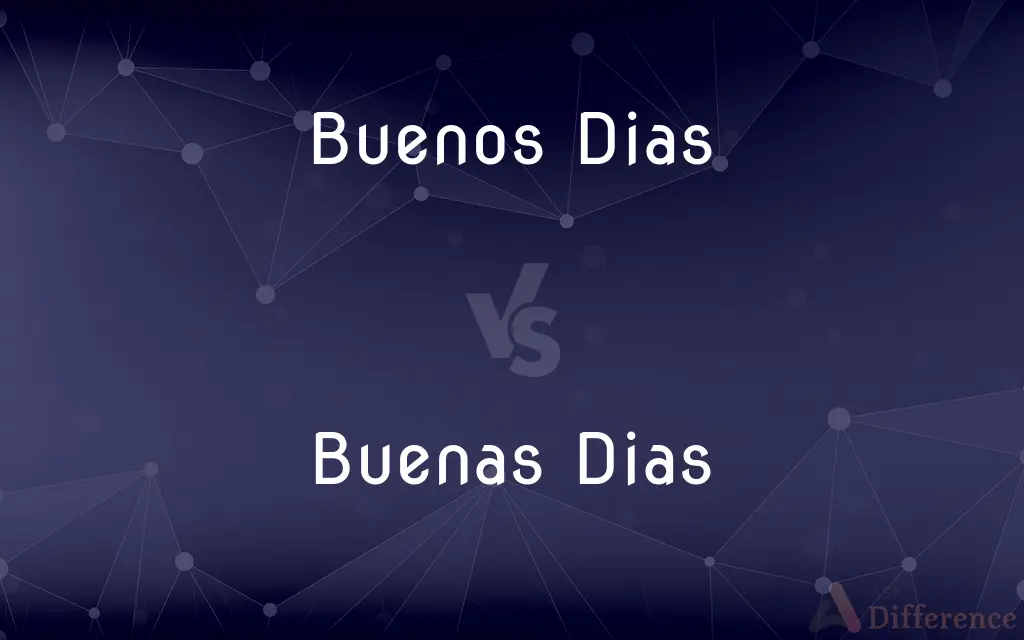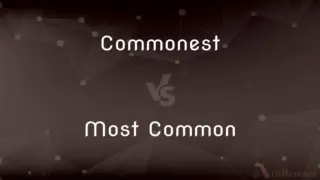Buenos Dias vs. Buenas Dias — What's the Difference?
By Tayyaba Rehman — Published on January 14, 2024
"Buenos Días" means "Good Morning" in Spanish and is grammatically correct; "Buenas Días" is a grammatical error, mixing feminine "Buenas" with masculine "Días."

Difference Between Buenos Dias and Buenas Dias
Table of Contents
ADVERTISEMENT
Key Differences
"Buenos Días" is the correct Spanish phrase used to greet someone in the morning. It translates directly to "Good Morning" in English. The word "Buenos" is the masculine plural form of "good" and correctly matches the masculine noun "Días" which means "days." "Buenas Días," however, is a common mistake since "Buenas" is the feminine plural form of "good," and should not be used with the masculine noun "Días."
In the Spanish language, adjective-noun agreement in gender and number is a fundamental rule. "Buenos Días" adheres to this agreement, using the masculine adjective and noun in their plural forms. "Buenas Días" demonstrates a discordance in gender agreement, which is not standard in Spanish grammar. Grammatically, "Buenas" would pair with a feminine noun, as in "Buenas Noches" (Good Night).
The use of "Buenos Días" is widespread in all Spanish-speaking countries, used in formal and informal settings alike. "Buenas Días," while sometimes mistakenly used, is generally recognized as incorrect and can be a marker of a non-native speaker or a slip of the tongue. It's not commonly found in written or educated spoken Spanish.
When teaching Spanish, instructors emphasize the correct form "Buenos Días" to students. Using the proper grammatical form is important for clear communication and is an indicator of language proficiency. In contrast, "Buenas Días" would typically be corrected during learning exercises and language practice to prevent the perpetuation of the error.
Lastly, "Buenos Días" can be found in Spanish language textbooks, official communications, and formal writings, reflecting the correct use of language. "Buenas Días," however, would likely only be encountered as an example of incorrect grammar to highlight the importance of gender agreement in Spanish adjectives and nouns.
ADVERTISEMENT
Comparison Chart
Gender Agreement
Correct (Masculine)
Incorrect (Feminine)
Usage
Common and Correct
Uncommon and Incorrect
Acceptability
Accepted Everywhere
Generally Not Accepted
Context
Formal and Informal
Typically, None
Recognized By
All Spanish Speakers
Often Corrected
Compare with Definitions
Buenos Dias
Standard morning greeting in Spanish.
When she entered the office, she cheerfully said '¡Buenos Días!' to everyone.
Buenas Dias
A grammatical error in Spanish.
The new learner mistakenly said 'Buenas Días' but quickly corrected himself.
Buenos Dias
Used to wish someone a good morning.
He opened his email with 'Buenos Días, team, let's have a productive day.'
Buenas Dias
Reflects a misunderstanding of gender agreement.
The Spanish app glitched and displayed 'Buenas Días' by mistake.
Buenos Dias
Can express politeness and warmth.
The teacher greeted her class with 'Buenos Días' before starting the lesson.
Buenas Dias
Unlikely to be used by proficient Spanish speakers.
Despite speaking fluently, he occasionally slips and says 'Buenas Días' with a grin.
Buenos Dias
Often used in formal correspondence.
The formal invitation started with 'Buenos Días, we are pleased to invite you...'
Buenas Dias
Seldom found in educational materials.
The textbook misprint showed 'Buenas Días,' which confused the students.
Buenos Dias
Reflects proper Spanish grammar.
In her Spanish test, Maria correctly wrote 'Buenos Días' at the top of the page.
Buenas Dias
May be heard in non-standard speech.
You might hear 'Buenas Días' in a playful context or as a joke.
Common Curiosities
Is "Buenos Días" formal or informal?
It can be used in both formal and informal settings.
Why is "Buenas Días" incorrect?
"Días" is masculine, so it should be "Buenos," not "Buenas."
Are there variations of "Buenos Días" in different countries?
The phrase is standard, but intonation and context can vary.
Is "Buenas Días" ever correct?
No, it's a grammatical error due to gender mismatch.
Can "Buenos Días" be used at any time of day?
It's typically used in the morning hours.
Should I correct someone who says "Buenas Días"?
Yes, politely, to help them learn correct Spanish.
What does "Buenos Días" mean?
It means "Good Morning" in Spanish.
Can "Buenos Días" be abbreviated in text messages?
Yes, sometimes it's shortened to "B. Días" or similar.
Will Spanish speakers understand "Buenas Días"?
They'll understand but recognize it as incorrect.
Is "Buenas Días" common among Spanish learners?
It can be a common mistake for beginners.
Does "Buenos Días" have the same meaning in all Spanish-speaking countries?
Yes, it universally means "Good Morning."
Is "Buenas Días" a regionalism?
No, it's not correct in any Spanish-speaking region.
What's the best way to learn the correct form, "Buenos Días"?
Practice speaking and listening to native Spanish speakers.
Could "Buenas Días" be considered a typo?
Yes, it could be a typo if the speaker knows it's incorrect.
How is "Buenos Días" pronounced?
It's pronounced as /ˈbwenos ˈdias/.
Share Your Discovery

Previous Comparison
HashMap in Java vs. TreeMap in Java
Next Comparison
Commonest vs. Most CommonAuthor Spotlight
Written by
Tayyaba RehmanTayyaba Rehman is a distinguished writer, currently serving as a primary contributor to askdifference.com. As a researcher in semantics and etymology, Tayyaba's passion for the complexity of languages and their distinctions has found a perfect home on the platform. Tayyaba delves into the intricacies of language, distinguishing between commonly confused words and phrases, thereby providing clarity for readers worldwide.












































